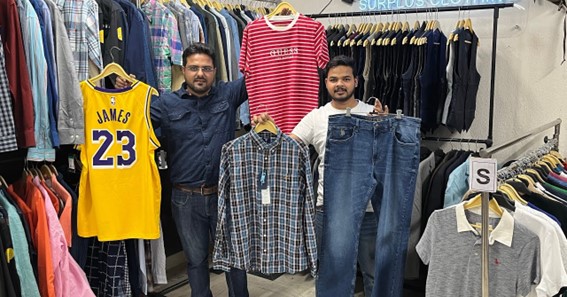Are you curious to know what is surplus clothes? You have come to the right place as I am going to tell you everything about surplus clothes in a very simple explanation. Without further discussion let’s begin to know what is surplus clothes?
What Is Surplus Clothes?
In our fast-paced consumer culture, the issue of textile waste has become a pressing concern. Surplus clothes, also known as excess or surplus inventory, refer to garments that remain unsold by retailers or manufacturers. In this blog, we will explore the concept of surplus clothes, the causes behind their accumulation, and the importance of addressing this issue for a more sustainable fashion industry.
Understanding Surplus Clothes:
Surplus clothes are the result of overproduction or misjudgment of consumer demand. When retailers or manufacturers produce more clothing items than they can sell, an excess inventory is created. These unsold garments can range from unsold seasonal collections to canceled orders or discontinued products.
Causes Of Surplus Clothes:
- Overproduction: The fashion industry operates on fast fashion principles, which often involve producing large quantities of garments to meet rapidly changing trends and consumer demands. Overproduction occurs when brands and retailers produce more clothes than can be sold within a specific time frame.
- Changing Consumer Preferences: Consumer preferences can shift quickly, and retailers may miscalculate the demand for certain styles or designs. This can result in excess inventory if the clothing items do not resonate with the target market.
- Cancelled Orders or Returns: In some cases, canceled orders or high rates of returns can lead to surplus clothes. This may happen due to production errors, changes in buyer preferences, or discrepancies between online representations and the actual product.
- Seasonal Collections: Fashion trends are inherently transient, with retailers needing to introduce new seasonal collections regularly. When new collections arrive, unsold items from the previous season become surplus clothes.
The Importance Of Addressing Surplus Clothes:
- Environmental Impact: Surplus clothes contribute to environmental degradation. The production of textiles requires significant amounts of natural resources, water, and energy. When garments are discarded, these resources go to waste, while the textile waste ends up in landfills or incinerators, contributing to pollution and greenhouse gas emissions.
- Social and Ethical Implications: Surplus clothes can have social and ethical implications along the supply chain. Overproduction may lead to labor exploitation, poor working conditions, and low wages for garment workers. Addressing surplus clothes involves promoting responsible production practices and fair treatment of workers.
- Economic Losses: Surplus clothes represent a financial burden for retailers and manufacturers. Excess inventory ties up capital and storage space, preventing businesses from investing in other areas. Addressing surplus clothes helps improve business profitability and resource allocation.
Solutions To Address Surplus Clothes:
- Responsible Production Practices: Brands and manufacturers can adopt responsible production practices such as implementing demand-driven production, reducing overproduction, and optimizing supply chain management. This includes forecasting consumer demand more accurately and adjusting production quantities accordingly.
- Sustainable Business Models: Embracing sustainable business models, such as slow fashion or circular fashion, can help reduce the generation of surplus clothes. These models prioritize quality, durability, and longevity, encouraging consumers to make conscious and mindful purchasing decisions.
- Collaboration and Innovation: Collaboration among stakeholders in the fashion industry, including brands, retailers, consumers, and policymakers, is crucial. Innovative solutions like clothing rental services, resale platforms, and recycling initiatives can help extend the lifespan of garments and reduce textile waste.
- Consumer Awareness and Engagement: Educating consumers about the impact of surplus clothes and promoting sustainable consumption practices is essential. Encouraging consumers to support brands that prioritize responsible production and offering information on clothing care, repair, and recycling can make a significant difference.
Conclusion:
Surplus clothes present significant challenges to the fashion industry and the environment. By addressing the root causes and implementing sustainable practices, we can reduce the accumulation of surplus inventory and work towards a more sustainable fashion ecosystem. Through responsible production, consumer awareness, and collaboration among stakeholders, we can create a fashion industry that minimizes waste, preserves resources, and promotes a more conscious and ethical approach to clothing consumption.
FAQ
What Is The Meaning Of Surplus Clothes?
The Extra garments are called stock lots or surplus garments. 🔰 Some of the garments are rejected by the buyer’s representative during the inspection. The main cause of rejection the quality does not meet the buyer’s requirement as per the order. These garments is also known as stock lot or surplus garments.
Are Surplus Clothes Original?
Export surplus stores sell original branded garments that may contain defective part(s) and/or defective trim(s). Garments with hidden defects that do not hinder the functionality of the garment are okay to many wearers as they choose to buy surplus products.
What Is The Surplus Brand Store?
A surplus store or disposals store is a business that sells items and goods that are used, purchased but unused, or past their use-by date, and are no longer needed due to excess supply, decommissioning, or obsolescence.
What Are Surplus Items?
A surplus describes the amount of an asset or resource that exceeds the portion that’s actively utilized. A surplus can refer to a host of different items, including income, profits, capital, and goods. In the context of inventories, a surplus describes products that remain sitting on store shelves, unpurchased.
I Have Covered All The Following Queries And Topics In The Above Article
What Is Export Surplus Clothes
What Is Surplus Branded Clothes
What Is Surplus In Clothes
What Is Surplus Clothes In Hindi
How To Buy Surplus Clothes From Company
Surplus Clothes Meaning In Hindi
What Is Surplus Branded Clothes
Export Surplus Clothes Meaning
Surplus Clothes Online
Where To Buy Surplus Clothes
Surplus Clothes Meaning In Tamil
Surplus Quality Meaning
What Is Surplus Clothes
What is surplus item
What is surplus garments?






